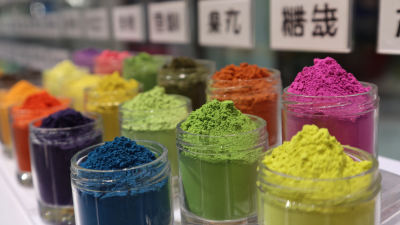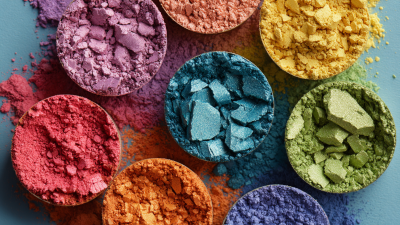In recent years, the use of mica powder in soap making has gained significant traction among artisans and small-scale manufacturers due to its ability to create visually stunning products. According to the Global Mica Market Report, the demand for natural colorants, including mica powder, has surged, with a projected growth rate of 7.5% annually through 2027. Mica powder not only enhances the aesthetics of soaps with vibrant colors and shimmering effects but also aligns with the increasing consumer preference for naturally-derived ingredients. Furthermore, the versatility of mica powder in soap formulations—allowing for layers, swirls, and patterns—has revolutionized creative possibilities in the industry. As more soap makers recognize its benefits, understanding how to effectively incorporate mica powder in soap becomes essential for achieving captivating visuals that stand out in a competitive market.

Mica powder, a naturally occurring mineral, has become a popular ingredient in the beauty industry, particularly in soap making. Comprised mainly of silicate minerals, the unique composition of mica powder gives it the ability to reflect light, resulting in stunning visuals that elevate the aesthetic appeal of soap products. Its fine texture and vibrant hues make it an ideal choice for artisans looking to create visually striking bars of soap, ensuring that each piece is a work of art.
In addition to its visual benefits, mica powder is valued for its skin-friendly properties. It is non-toxic and typically safe for use in cosmetics, making it an excellent option for those focused on crafting products that align with sustainable beauty practices. However, the sourcing of mica has raised sustainability concerns. Ethical sourcing of mica is essential to prevent exploitation and environmental degradation. By choosing responsibly sourced mica powder, soap makers can not only enhance their creations but also support ethical practices in the beauty industry.
When it comes to enhancing the visual appeal of homemade soap, mica powder is a top choice among crafters. There are two main types of mica powder to consider: natural and synthetic variants, each offering unique benefits and effects. Natural mica powders, derived from minerals, are prized for their biodegradable and eco-friendly properties. They come in a range of beautiful earthy tones and shimmer, adding a subtle elegance to soaps while ensuring safety for skin and the environment.

On the other hand, synthetic mica powders provide vibrant colors and outstanding brilliance that can make your soaps truly eye-catching. These variants often have a more consistent color payoff and aren’t affected by pH levels, which can alter the hues of natural micas. However, they may not always be as eco-friendly, so it's essential to weigh the visual benefits against your environmental values. Understanding the differences between these types will help you choose the right mica powder for your soap-making projects, ensuring stunning results while aligning with your crafting ethos.
Mica powder has emerged as a game-changer in the realm of soap making, significantly enhancing the aesthetic appeal of handcrafted bars. The shimmering effects created by mica powder not only add depth to the soap but also cater to the growing consumer demand for visually striking products. Consumers are increasingly favoring artisanal soaps that offer unique and vibrant colors, driven by a desire for individuality in their personal care items. As a result, the incorporation of mica powder has become a preferred method for soap makers looking to meet these aesthetic trends.
Moreover, the impact of mica powder on consumer preferences extends beyond mere visuals. Many buyers are drawn to the artisanal aspect of soaps that utilize natural mineral pigments, associating them with higher quality and organic ingredients. This trend is reshaping the marketplace, as shoppers seek out brands that prioritize aesthetic appeal alongside sustainability. Soap makers are thus encouraged to experiment with various mica powder formulations to create bespoke products that not only look stunning but also resonate with the values and preferences of today’s consumers.
Incorporating mica powder into soap formulations can elevate the aesthetic appeal of your creations significantly. To get started, ensure you select high-quality mica powders specifically designed for use in cosmetics. These powders not only provide vibrant colors but also possess skin-safe properties. Begin by carefully measuring the mica powder, as a little goes a long way. A common practice is to mix 1 to 2 teaspoons of mica into a small amount of carrier oil before adding it to the soap base, ensuring even distribution and preventing clumping.

When adding mica to your soap, timing is crucial. Introduce the mica mixture to the soap base at a temperature below 120°F (49°C) to maintain the integrity of both the color and fragrance. Stir vigorously, but gently, to avoid incorporating too many air bubbles. Layering different colors can create stunning effects, so consider pouring your soap in stages — allowing each layer to set partially before adding the next color. This approach not only enhances the visual depth but also adds an element of design that can make your soap truly unique. Always experiment with different combinations and techniques to find what works best for your personal soap-making style.
When incorporating mica powder into cosmetic products, particularly soap, it’s crucial to navigate the regulatory landscape effectively. Mica, a naturally occurring mineral, is prized for its ability to impart shimmering hues and textures. However, its use is subject to various regulations due to concerns over sourcing practices and potential environmental impact. According to a report by the Cosmetic Ingredient Review (CIR), mica sourcing involves complex supply chains, predominantly from countries such as India, where mining practices can result in significant social and environmental issues.
Moreover, the U.S. Food and Drug Administration (FDA) provides guidelines on the labeling of mica-containing products, ensuring that crafters and manufacturers disclose the presence of this ingredient accurately. The Personal Care Products Council emphasizes the importance of using mica sourced from transparent supply chains that uphold ethical mining practices. As consumers increasingly demand transparency, brands are encouraged to adhere to regulatory standards while responsibly sourcing mica to maintain both compliance and consumer trust. The Global Mica Coalition also highlights the need for ongoing efforts to improve conditions in mica-producing regions, reinforcing that ethical considerations should complement regulatory adherence in the cosmetic industry.






